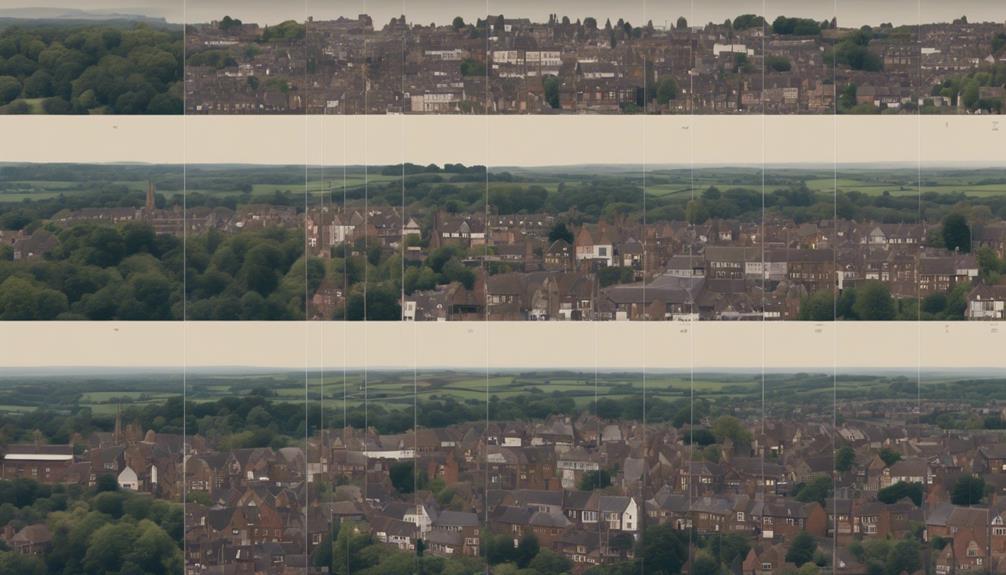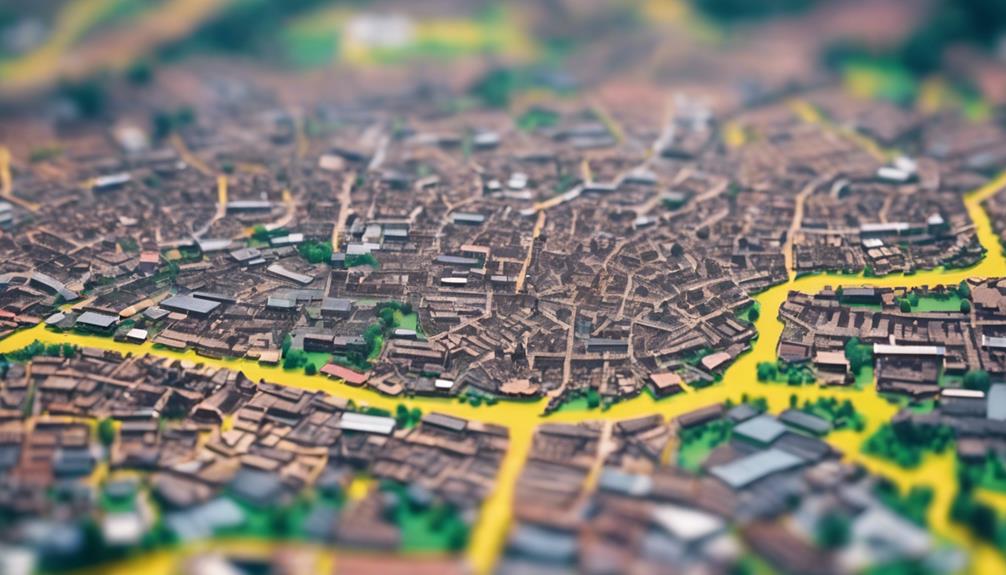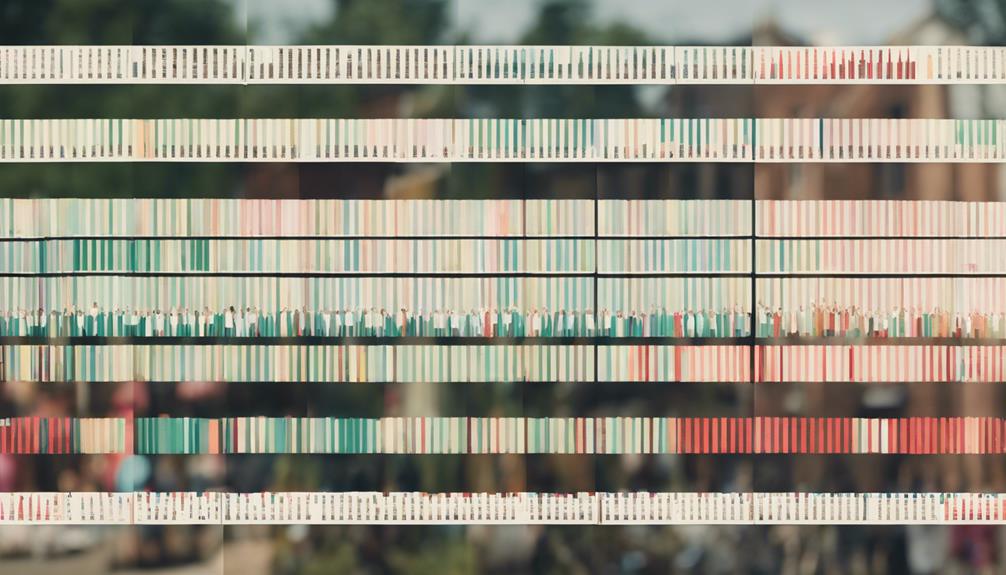Population Growth Projections in Staffordshire Towns
In Staffordshire towns, population growth is on the rise. Stoke-on-Trent is expanding due to job opportunities. Fastest-growing towns like Stafford are seeing notable increases in residents. Projections suggest a steady growth rate, with demographic shifts expected. Cannock Chase, Lichfield, Tamworth, and Stafford have varying population densities. Urbanization and migration patterns play a key role in shaping these changes. Forecasting future trends is essential for infrastructure planning. Intrigued by the dynamic population trends in Staffordshire towns? Keep exploring to uncover more about the anticipated shifts driving economic and demographic changes in the region.
Key Takeaways
- Stoke-on-Trent anticipated to see continued population increase from job opportunities.
- Stafford projected for remarkable population growth due to expanding industries.
- Demographic shifts expected in evolving towns impacting population dynamics.
- Average age of population likely to shift further based on birth rates and migration.
- Sustainable growth strategies needed to accommodate projected population changes.
Population Trends in Staffordshire Towns
Examining the population trends in Staffordshire towns reveals a dynamic interplay of factors shaping their growth and development. In towns like Stoke-on-Trent, the availability of employment opportunities plays a significant role in attracting new residents and fostering population growth. As industries expand and new businesses emerge, more job openings become accessible, drawing individuals and families seeking work and economic stability. This influx of people contributes to the overall growth of the town and creates a vibrant community where individuals can find their place and contribute to the local economy.
Moreover, housing affordability is another essential factor influencing population trends in Staffordshire towns. The ability to find suitable and reasonably priced housing options is vital for attracting new residents and retaining current ones. Towns that offer a range of affordable housing choices tend to experience steady population growth as individuals and families are more likely to settle down and establish roots in a place where they can afford to live comfortably. By ensuring a balance between employment opportunities and housing affordability, Staffordshire towns can continue to grow sustainably while meeting the needs of their residents.
Fastest Growing Towns in Staffordshire
Staffordshire's fastest growing towns are experiencing significant population surges due to factors such as economic development and infrastructure improvements. Stafford, in particular, stands out as one of the fastest-expanding areas in the region. The town has seen a remarkable increase in its population in recent years, surpassing many other areas in Staffordshire. This growth is attributed to the rise in employment opportunities and the enhancement of housing affordability within the town.
Employment opportunities play a vital role in attracting individuals and families to Stafford, as job seekers are drawn to areas with promising career prospects. Additionally, the town's focus on improving housing affordability has made it an appealing choice for many looking to settle down or invest in property. As a result of these factors, Stafford is projected to continue experiencing population growth in the years to come. The town's upward trajectory showcases its potential for further development and prosperity, making it a desirable location for those seeking a thriving community to call home.
Projected Population Changes in Staffordshire

In Staffordshire, Stoke-on-Trent is expected to see a population increase over the coming years, with projections indicating a steady growth rate. This growth trend suggests potential future demographic shifts within the town, impacting various aspects of community life and infrastructure planning.
Understanding these projected population changes is vital for local authorities and residents to prepare for the evolving needs and demands of a growing population.
Growth Trends Analysis
The population growth trends in Staffordshire towns reveal a dynamic landscape of shifting demographics and projected changes. When analyzing the growth trends, it's evident that Staffordshire is experiencing a mix of population dynamics. Some areas are seeing increases in population, while others are facing declines. Stoke-on-Trent, for instance, is projected to have a slight decrease in 2024 by 0.6% compared to 1950 figures, but by 2025, it is expected to rise to 396,812 residents. Looking ahead to 2035, the population in Stoke-on-Trent is forecasted to reach 423,494. Additionally, the average age of the population in Staffordshire has been shifting, with some areas getting older and others trending younger since 2002.
| Population Trend | Projected Change |
|---|---|
| Increase | Stoke-on-Trent |
| Decline | Some areas |
| Shifting Age | Older, Younger |
Future Demographic Shifts
Anticipate significant demographic shifts in Staffordshire towns as population projections indicate a steady rise in residents over the coming years. With a projected population of 396,812 in 2025 and an estimated growth rate of 0.6% in 2024, Staffordshire is on track for continued expansion.
By 2035, the population is expected to reach 423,494, showcasing a trend of steady growth since 1950 when the population was 399,837. This growth implies changes in the town's dynamics, potentially leading to increased employment opportunities and a shift in housing affordability.
As more people choose to settle in Staffordshire, the demand for jobs and homes is likely to rise, influencing various aspects of community life.
Demographics of Staffordshire Towns
With a diverse population hailing from various backgrounds and countries, the demographics of Staffordshire towns showcase a rich tapestry of residents. An ethnic diversity analysis reveals that while the majority of residents are white, there's a growing representation of various ethnic groups, adding vibrancy to the cultural landscape. In terms of religious demographics, a significant percentage of residents follow Christianity, shaping the spiritual fabric of these towns.
The average age of residents in Staffordshire towns is influenced by factors like birth rates and migration patterns. These demographic intricacies play a pivotal role in understanding the community dynamics and social interactions within the towns. As population growth continues to be influenced by birth rates, mortality rates, and migration, demographic changes will have a significant impact on services, infrastructure, and community planning in Staffordshire towns. Understanding the demographics of these towns is essential for fostering a sense of belonging and inclusivity among residents.
Population Density in Staffordshire

In Staffordshire, the population density varies significantly across different towns, highlighting the diverse urban landscapes within the region. The population density variations are quite noticeable, with Cannock Chase having around 1,500 people per square mile, Lichfield with approximately 1,100 people per square mile, Tamworth exceeding 2,300 people per square mile, and Stafford reaching about 2,700 people per square mile.
These numbers show how densely populated these towns are, each with its unique characteristics and community vibes. As urban expansion projections continue to shape these areas, the population density is expected to evolve, impacting the overall living environment and resources available to residents.
Understanding these variations can provide insights into the dynamic nature of Staffordshire's towns and the potential changes they might undergo in the future. Whether you reside in a bustling town like Tamworth or a more moderately populated one like Lichfield, the population density plays an essential role in defining the daily life and interactions within these communities.
Age Distribution in Staffordshire Towns
The age distribution across Staffordshire towns presents a diverse mix of residents spanning various generations. Understanding this diversity is key for developing community programs that cater to the needs of all age groups. Here are some key points to consider:
- Age diversity: Staffordshire towns have residents of all ages, creating a vibrant and dynamic community.
- Community programs: Tailored programs can enhance the sense of belonging and address the unique requirements of different age groups.
- Factors influencing age distribution: Migration patterns, birth rates, and local amenities can impact the average age in a town.
- Planning for the future: By analyzing age demographics, towns can better plan services and infrastructure to support residents of all ages.
Comparative Population Growth Rates

Exploring the population growth rates in Staffordshire towns reveals a promising trend for future demographic shifts. The comparative population growth rate of 0.6% in 2024, as seen in towns like Stoke-on-Trent, indicates positive population dynamics within the region. This growth rate is mirrored in the projected population of 396,812 for Stoke-on-Trent in 2025, with further expansion expected as the population is estimated to reach 423,494 by 2035. Staffordshire's overall population growth rank showcases a favorable trend in population expansion, highlighting the region's potential for development and growth.
When looking at regional comparisons, Staffordshire towns are demonstrating steady progress in population growth compared to other areas. The comparative population growth rates in Staffordshire towns not only reflect a positive outlook for future demographic changes but also signify the region's allure for potential residents seeking a sense of community and belonging. As population numbers continue to rise steadily, Staffordshire remains an attractive destination for those looking to be part of a growing and thriving community.
Urbanization in Staffordshire
Amidst the evolving landscape of Staffordshire, urbanization has been a pivotal driver of population growth in towns like Stoke-on-Trent. The impact of urbanization goes beyond mere numbers; it shapes the very essence of these communities.
- Vibrant Communities: Urbanization fosters vibrant communities where interaction and connectivity thrive.
- Economic Opportunities: Urban areas like Stoke-on-Trent offer diverse economic opportunities for residents.
- Cultural Diversity: The urban landscape of Staffordshire, including Stoke-on-Trent, is a melting pot of cultures and traditions.
- Infrastructure Planning: As urbanization continues, meticulous infrastructure planning becomes vital to sustain the growing population.
Urbanization's impact is undeniable, transforming Staffordshire towns into bustling hubs of activity and growth. The need for strategic infrastructure planning is essential to guarantee these areas remain livable and prosperous. As Staffordshire evolves, embracing the changes brought about by urbanization can lead to a sense of belonging and pride in the communities you call home.
Migration Patterns in Staffordshire Towns
Migration patterns in Staffordshire towns exhibit a dynamic interplay between people coming in and going out. Many individuals move to these towns for employment prospects in industries such as ceramics and pottery.
On the other hand, younger residents often leave in pursuit of education or job opportunities in larger urban areas.
Migration Impact Analysis
As individuals relocate to Staffordshire towns, the dynamic interplay of diverse migration patterns significantly shapes the local population landscape.
- Migration brings in people from countries like Poland, Germany, Ireland, Italy, Nigeria, and Turkey.
- Ethnicity, religion, and average age are influenced by migration patterns.
- Migration can impact the growth rate of towns, either increasing or decreasing population numbers.
- Understanding migration trends is important for predicting future population changes and planning for infrastructure and services.
These migration patterns not only affect the economic landscape but also play a vital role in cultural integration within Staffordshire towns. By analyzing these migration impacts, town planners can better prepare for the future and make sure that residents feel a sense of belonging in their evolving communities.
Demographic Shifts Overview
Examining the demographic shifts in Staffordshire towns reveals a dynamic interplay of both inbound and outbound migration movements shaping the local population landscape. Some towns experience net migration gains, while others face net migration losses due to factors like job opportunities, housing affordability, and quality of life.
Towns with growing industries tend to attract more inbound migration, leading to fluctuations in population dynamics. Understanding these demographic changes is essential for local authorities to plan adequately for infrastructure, services, and community development.
Forecasting Future Population Trends
To predict future population trends in Staffordshire towns, analyzing historical data and applying statistical models is essential for strategic planning and decision-making. Understanding the population growth projections in Staffordshire towns is vital for local authorities and policymakers to make informed decisions about resource allocation and urban planning.
- Population forecasting methods: Utilizing advanced statistical techniques can help in making more accurate predictions about future population trends.
- Challenges in forecasting: Factors such as migration patterns, birth rates, and economic shifts pose challenges in accurately forecasting population growth.
- Socioeconomic implications of population growth: As the population in Staffordshire towns increases, there will be a need for expanded infrastructure, healthcare services, and educational facilities to support the growing community.
- Strategic planning for the future: By anticipating demographic shifts and population trends, local authorities can proactively plan for the future needs of Staffordshire towns, ensuring sustainable growth and development.
Conclusion
To summarize, Staffordshire towns are experiencing different rates of population growth, with some towns growing faster than others. Demographic changes, population density, and urbanization are key factors influencing these patterns.
Migration patterns also have a significant impact on shaping the future population landscape of Staffordshire. By grasping these projections and trends, local authorities can better plan for the future needs of their communities and guarantee sustainable development for all residents.

